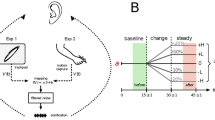Abstract
Response characteristics of human operators in manual pursuit tracking with auditory input are investigated. The human operator hears in his left ear a sound whose frequency varies in proportion to an external random signal. At the same time, he hears in his right ear another sound whose frequency varies in proportion to the angle of a control lever of a potentiometer. The operator controls the angle of the lever so that the frequencies of the sounds in both ears remain as close as possible. The dynamics of the human operator is studied by assuming a “manmachine system” whose input is the external signal and whose output is the voltage of the potentiometer. A learning identification method proposed by one of the authors is used to calculate the weighting function of the man-machine system, which is displayed on a CRT screen in real time. During the tracking task, the skin potential activity (SPA) is measured as an index of arousal of the operator.
Similar content being viewed by others
References
Leiderman, P.H., Shapiro, D.: Studies on the galvanic skin potential level: some behavioral correlates. J. Psychosom. Res. 7, 277–281 (1964)
McRuer, D.T., Graham, D., Krendel, E.S., Reisener, W.: Human pilot dynamics in compensatory systems: theory, models, and experiments with controlled element and forcing function variations. Wright-Patterson AFB, Ohio, AFFDL-TR-65-15, July 1965
Mirchandani, P.B.: An auditory display in a dual-axis tracking task. IEEE Trans. Syst. Man. Cybern. SMC-2, 375–380 (1972)
Nagumo, J., Noda, A.: A learning method for system identification. IEEE Trans. Autom. Control AC-12, 282–287 (1967)
Nagumo, J., Sato, S., Noda, A.: Real-time display system of response characteristics of manual tracking systems. IEEE Trans. Man-Mach. Syst. MMS-11, 212–216 (1970)
Rao, C.R.: Advanced statistical methods in biometric research, Chap. 7, pp. 258–264. New York: Wiley & Sons 1952
Sheridan, T.B.: Time-variable dynamics of human operator systems. MIT Dyn. Anal. and Contr. Lab., Cambridge, Mass., Rept. R-124, March 1960
Surwillo, W.W., Quilter, R.E.: The relation of frequency of spontaneous skin potential response to vigilance and age. Psychophysiology 1, 272–276 (1965)
Vinje, E.W., Pitkin, E.T.: Human operator dynamics for aural compensatory tracking. IEEE Trans. Syst. Man Cybern. SMC-2, 504–512 (1972)
Wierwille, W.W.: A theory for optimal deterministic characterization of time-varying human operator dynamics. IEEE Trans. Hum. Factors Electron. HFE-6, 53–61 (1965)
Young, L.R.: On adaptive manual control. IEEE Trans. Man-Mach. Syst. MMS-10, 292–231 (1969)
Author information
Authors and Affiliations
Rights and permissions
About this article
Cite this article
Takashima, M., Yoshizawa, S. & Nagumo, J. Human operator dynamics in manual tracking systems with auditory input. Biol. Cybernetics 37, 159–166 (1980). https://doi.org/10.1007/BF00355454
Received:
Issue Date:
DOI: https://doi.org/10.1007/BF00355454




